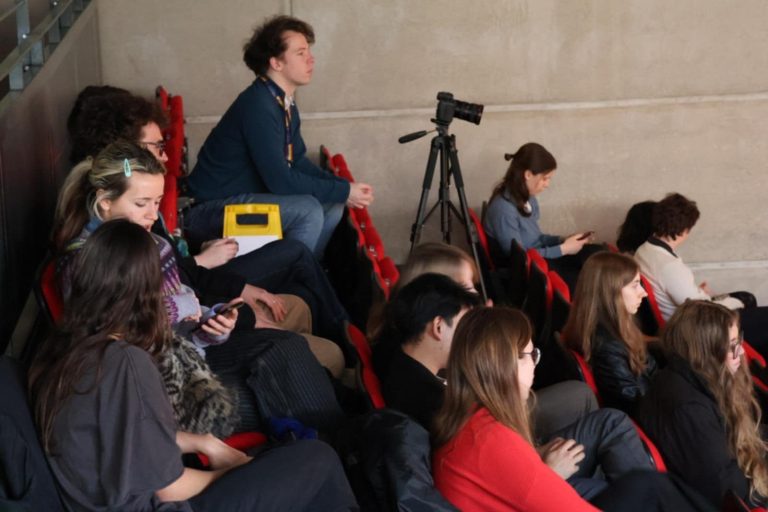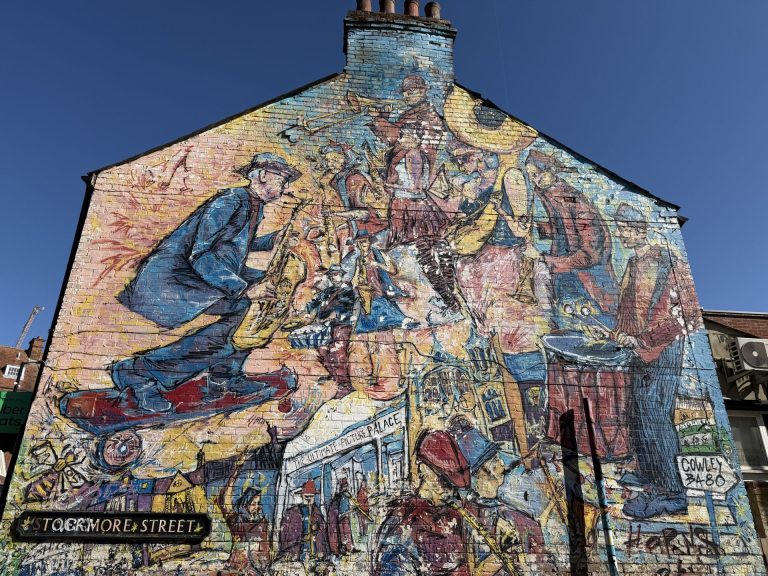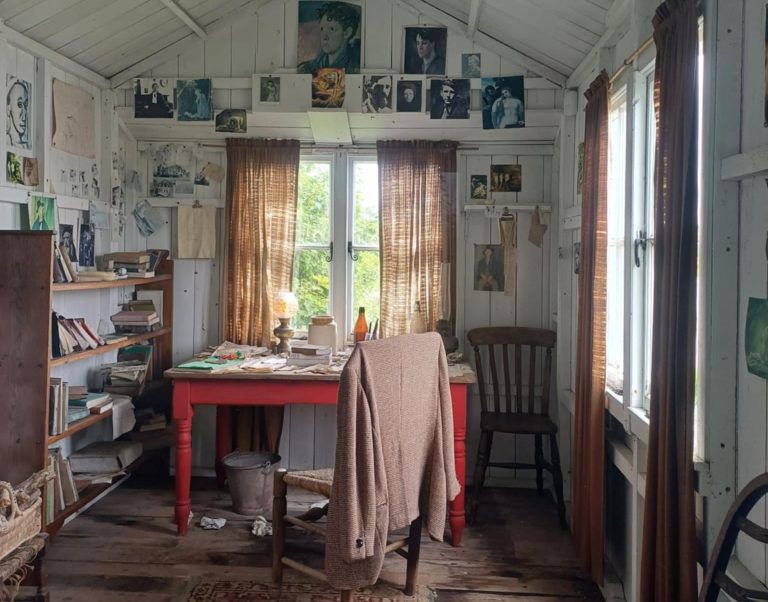The Oxford University Short Film Festival took place at the end of last term in Keble O’Reilly Theatre. Each day featured a variety of well-crafted student films, and day two was no exception. Six student films were broadcasted, each reviewed below.
Skelter
The first film of the night, directed by Max Morgan, depicts a girl moving on from her summer job at a fairground and all the emotional disconnection and reorientation that entails. It’s set on her last day of work as she says goodbye to a close friend. The film mines a similar economical, hesitantly emotional vein as the films of Colm Bairéad and Charlotte Wells. Its storytelling is assuredly minimal, preferring to hesitate on shots of the environment and pitch its conversations in a place of naturalistic awkwardness.
This approach allows the film to ascend towards a moment of thematic unity as the protagonist descends the eponymous helter skelter for the last time. This scene, greatly enhanced by Aris Sabetai’s overwhelming score combined with the laconic and alienating images of the disassembly of the fairground, leads to a moment of poetic insight as we watch the pair of friends recoiling from and parodying their previous emotional closeness. Their performances affect this admirably, with a real attention to detail in the small expressions that complement the film’s minimalism.
On a more critical note, though the writing is for the most part subtle, it can feel a bit obvious. Stripping it back even further and leaning into the Hemingway-esque economy, even extending some of the environmental storytelling and slowing the pacing (as in the films of Béla Tarr) would accentuate what is a really interesting style.
Drift
The second film, directed by Emily Florence Batty, explores the nostalgic friendship between Lily and Rachel, separated after Lily leaves for university. The film is cut through with cold blue snapshots of their final moments together before they left off with an argument. The weight of their disconnect sits heavily on the film, and the non-linear storytelling allows these two emotional moments to pervade each other.
The film draws on the naturalistic dialogue and subject matter of Normal People, attempting to capture a newly digitized and fractured experience of youth. The cinematography and pacing are excellent, moving the relationship towards its eventual reconciliation. The film’s only limitations are in its writing; some of the scenarios feel clichéd, and the dialogue can be overly expository. However, this does not mar what is a skilful and focused relationship study.
Bright Young Things
The third film, directed by Katie Burge, centres on the relationship between Pia and Soph as they struggle to negotiate youth and morality. The film opens with a dreamlike sequence as Pia sparkles in a black void, fluttering around a star. We wake up on Pia’s 20th birthday as the two friends plan the party they will have that evening. Pia speaks in Waughian lyrics and half-finished ideas, relishing the confusion of her interlocutor. Soph is excited and happy, a lamb for Pia to lead, a dream for her to invent. When Pia kisses the boy that Soph likes at the party, the two fall out. Pia’s self-conscious charisma is imitated by Soph, who then undermines it and exposes its artificiality.
Soph emerges as the emotional core of the film amidst a world of sparkling appearances and inauthenticity. Meaning or morality is banished by a set of glimmering ideals, and youth is something illusory and performative. The film’s dialogue, while contrived at points, is spaced out to allow ambiguity to emerge. Defying any easy resolution, the film’s pessimism is itself unsure and seems to seek for some fragile humanity in its characters. It is a very effective short film, compelling in its dialogue and ambiguous in its conclusions.
It’s My Party
In the fourth film, directed by Rosie Robinson, Louisa’s two awful flatmates throw her a 22nd masked birthday party without inviting anyone that she knows. Through small hints dropped throughout the film we learn about the underlying emotional and familial struggles facing the character and their experience of chronic pain as the party descends into a distorted nightmare. It walks a thin line between comedy and horror, pushing into moments of Eyes Wide Shut-esque terror; we are drawn into the turmoil of the protagonist as the party becomes a wider symbol of an unknowable and overwhelming anxiety.
However, Lili Herbert’s fantastic performance always brings us back to humour with an incredulous facial expression. The main love interest’s conversational tone also follows this rhythm, toeing the line between awkwardness and emotional assurance. This sets a brilliant atmosphere, one that depicts the simultaneous comedy and total alienation of the scenario. The final scene is heartwarming, with great chemistry between the actors and a satisfying emotional resolution. My only critique would be that this ending loses the absurdist edge of the film’s opening.
Cloud Nine
The fifth film, directed by Theo Shorrocks, is a Richard Curtis inspired portrait of contrasting experiences of love. A real interview of an older couple is juxtaposed against the trials and tribulations of a pair of young would-be lovers. The use of the interview footage really elevates the film as their genuine and naturally complex dynamic sits on top of and shifts perceptions of the secondary storyline.
This contrast makes the young lovers seem one-dimensional, but in the same way that Richard Curtis’ characters are deliberately one-dimensional. As such, the film takes apart the Curtis formula, sitting in a place of tension that is at times genuinely heartwarming and at others self-aware of its own limitations. This stops it from synthesising in an emotional conclusion or reaching any final judgement on the theme of love (outside of its precarity), but this is also the film’s greatest strength, leading us into a nostalgic place of uncertainty where narratives of love and real love combine and are muddied. The film’s technical aspects are all excellent, with great pacing, editing, and cinematography.
Strangers
In the final film, directed by Mischa Gurevich, a chance encounter and an unexpected proposition explodes into a haze of dreamlike cinematography as the protagonists dance through an empty building at sunset. The voiceover ruminates on the impossibility of love and the contrast between the immediacy of their connection and the need for hesitation.
It is under half of the length of the other shorts, but it makes the most of its short runtime by disregarding character and relying on the ambiguity of its images. The film is more of an emotional rush than a cognitive experience, plunging between extremes emphasized by the granular sounds of glass and pulsing soundscapes.
Final Thoughts
The festival organisers did a great job setting up and chairing the evening, which ended with a panel with some of the directors. The films were interesting when taken as a set. They had quite a lot in common. Almost all were shot in 4:3. Almost all used a retro, nostalgic colour grade. Almost all, with notable exceptions, attempted a form of social realism. In most cases this was achieved through the use of minimal dialogue. As you would expect given the age range, most explored themes of fleeting youth, university life, or failing love. They were curated based on the theme of ‘interpersonal relationships’, which makes sense; most were interested more in exploring the relations between individuals rather than any wider social concerns. However, in this interpersonal isolation they were unified by their sense of nostalgia and hesitancy, which seems to reflect on a particular historical moment.










